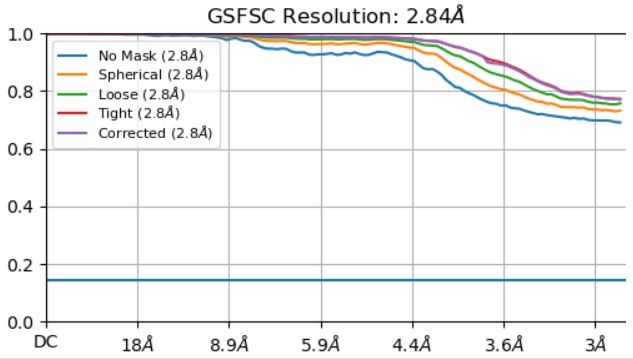Dear cryoSPARC community,
I’m a new cryoSPARC user and I’d like to have some help regarding the FSC of a helical filament.
I’ve imported my best refinement run of a helical processing job from Relion into cryoSPARC and I’ve used two refinement methods to run a new refinement: the “non-uniform refinement (new)” and the “helical refinement”.
For both refinements, I’ve used a mask imported from Relion and later also a mask created using Chimera (as suggested in the cryoSPARC guide).
The output of the “helical refinement” gives a nice FSC curve, whereas the FSC of the “non-uniform refinement (new)” does not go to zero (see attachment).
However, while the output of the “helical refinement” is nice, the output of the “non-uniform refinement (new)” is better resolved, and it highlights some interesting details that are averaged out in the “helical refinement” output.
For this reason, I would like to use the output map of the “non-uniform refinement (new)”. I found basically the same question asked by another user in October for a icosahedral particle and the only answer was that this is probably due to high symmetry and particle density.
So I wonder if there is a way to fix the FSC curve from the “non-uniform refinement (new)”?
Thank you!
Additional info:
cryoSPARC version: 3.1.0
CUDA version 10.2
OS Scientific Linux 7.9

1 Like
Hi @Lavinia,
Thanks for reporting! This is almost certainly due to the initial picking of the particles being very close together. If particles from the same filament aren’t sorted into the same half-map during refinement, they will have the same effect as duplicated particles, and the half maps will not be independent. This means the maps will have severely inflated resolution, and likely contain overfitting. The non-uniform refinement (NEW) job doesn’t split particles accounting for this, and so these maps likely contain significant overfitting that can’t be trusted as true density.
The helical refinement job is able to deal with this, i.e., if the particles were imported from RELION (and possess the rlnHelicalTubeID field that uniquely identifies each particle with a different filament), this will be tracked and the helical refinement should correctly split the particles such that particles from the same filament end up in the same half-map. If there isn’t sufficient info to do this, it will print a warning to the stream log. For this reason, if you are processing helical picks, it is recommended to only use helical refinements instead of non-uniform refinements or homogeneous refinements.
Since you are on v3.1.0, helical refinement jobs should be able to recreate the functionality of the non-uniform refinement job. In the parameters, simply turn on the Use Non-Uniform Refinement? switch, and it will use the same regularization process as the non-uniform refinement job. To deactivate the application of helical symmetry, you can simply leave the Helical twist estimate (degrees) and Helical rise estimate (Angstrom) parameters both blank. The functionality should be essentially the same as the non-uniform refinement job, except with correct half-map splitting. Note that deactivating helical symmetry will probably give lower resolution results than activating helical symmetry, unless the information that has been “averaged out” from applying helical symmetry is truly strong enough to align particles with.
Let me know if you have any other questions! Best,
Michael
2 Likes
